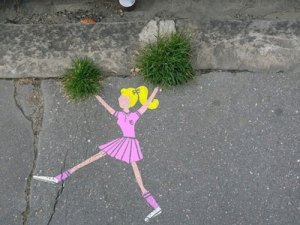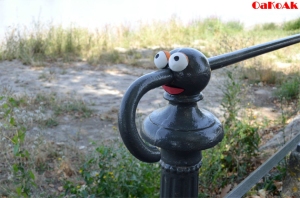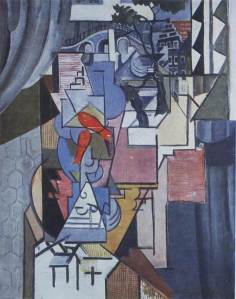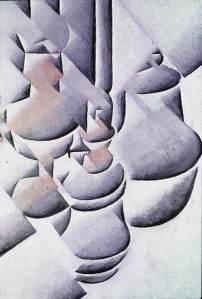


 In my research of “Street Art” I found some funny creations. Very cute. What do you think?
In my research of “Street Art” I found some funny creations. Very cute. What do you think?
Latest Entries »
The painting below titled “Goldfish by the Window” by Emil Filla. It is oil of canvas. He used a limited palette which is a common characteristic of cubism. The choices of colors establish a cool sensation, one that is synonymous with Czechoslovakia. I found it unique that he would use local colors for his representations, since it is most common for cubists to use arbitrary colors. As I look at the smaller images that appear to be outside the window, I see a patchwork of the artist’s soul.

The industrial revolution changed our society in many ways. The effect it had on society was also evident in the progression of art. This era saw many developments that certainly had an impact on people’s lives and the way people viewed the world around them. The creation of wealth empowered private citizens, which assuredly opened the palette of content. No longer was art only being stimulated by the church or royalty, art was now being commissioned by private individuals. Cities were prospering, which attracted many people to them. In addition to the prosperity, the city represented a side of life that was new to so many.
This new attitude in society encouraged “Romanticism,” one of the first movements of the era. Romanticism was not based on a particular style, but a representation of attitude and the characteristics of the subjects in the piece. Emotion and individual experiences were the basis for the work, however imagination set their tone. Romantic artists used real life situations and elaborated on them, creating an emotional and dramatic depiction. Providing the viewer a glimpse of just how the emotions within the characters may have been.
From Romanticism was born Realism, a movement with a focus on every day and the ordinary. Realists were set on breaking free of history. Realism gave birth to the Impressionism, a style not dependent on perfection. This movement was passionate about the outdoors, capturing an emotion of a specific place or event. Impressionists sought to capture a sensation through their landscapes, not just a depiction of the landscape. They used a lightened palette of bright and contrasting shades.
Expressionism was a nearly abstract style that employed colors to express motion and characters. The Fauvists use of arbitrary colors was because they did not want to confine themselves use of “real” colors.
Expressionism opened the door for another movement, Cubism. This movement was initiated by Pablo Picasso and Georges Braque. It’s a nearly abstract style with the content camouflaged within a variety of geometric shapes. This challenged the traditional representation perspective by implementing different views of perspective in the painting.
 I found the perspective of this painting of “Still Life” by Juan Gris amazing. He accomplished so much with a limited palette. His ability to create an image that almost appears three dimensional is awesome. The content is quite simple, so my attention is drawn to the way he shaded, creating an awesome perspective.
I found the perspective of this painting of “Still Life” by Juan Gris amazing. He accomplished so much with a limited palette. His ability to create an image that almost appears three dimensional is awesome. The content is quite simple, so my attention is drawn to the way he shaded, creating an awesome perspective.
The influence of Picasso on modern art was quite profound. Reading his dialog revealed some interesting points of view. He explained how sometimes his work provides him a release, an outlet for his feelings and visions. Therefore, how could a person really know what his work is trying to say? He expresses much disapproval to the ones who anointed themselves as the creators of convention. In addition, he has contempt for those who control the museums, calling them imposters. Ultimately, Picasso sees no purpose in explanation; the viewer only needs to enjoy the bird’s song.
Images Cited:
Image #1
AR: Filla, Emil, 1882-1953
TI: Goldfish by a Window
DT: 1916
AA: ARTstor
CN: ARTSTOR_103_41822000679272
Image #2
AR: Gris, Juan, 1887-1927
TI: Still Life with Oil Lamp
DT: 1912
AA: ARTstor
CN: ARTSTOR_103_41822001233897

“Livia, Villa of: garden room mural”. Photograph. Encyclopædia Britannica Online. Web. 28 Mar. 2013.
The Roman sculptors believed in more realistic poses with the intentions portraying life as they saw it. Their naturalistic features revealed a sort of story of the kind of life they lived and who they were in their society. They developed what is known as Roman virtues and they became symbolic in Roman sculptures. The two virtues, Fides and Concordia, fides represents reliability and there must be a sense of trust between two parties if a relation between the two was to exist. The virtue Concordia was to represent harmony between the two. The Roman sculpture of Marcus Aurelius on his horse has beautiful detail and the sculptor captures the naturalistic style in an effort to commemorate this great leader. This sculpture brings the image to life; one can almost hear him commanding his troops. His form shows great unity with his horse. The Roman’s sculptures are direct descendants to the sculptures we can see today in monuments throughout our country.
The Roman culture put great emphasis on their architecture. The buildings contained magnificent frescos that were representational of real life. In addition to their realistic sculptures, the Romans were prolific in the creation of frescos. These frescos were naturalistic paintings on plaster walls usually encompassing the entire wall surface. Some were of a sacred theme involving something from a cultic ritual, and all are proportional to what it’s depicting.
Maintaining a consistent proportionality to life outdoors, they painted many frescos within their villas. A beautiful example of such work is found in the villa of Livia. Caesar Augustus had this villa built for his wife, Livia as a retreat to relax in. The walls were painted as representation of the naturalistic beauty outside. The concrete walls probably kept it cool in the hot summer months, and the images of the trees created a sense of coolness. The atmospheric perspective established by the artist contributed to the cool feeling one could almost hear a breeze in the trees. Within the walls was a wonderful use of a variety of trees and flowers, also natural unity existed between the plants and birds. The content and form the Roman artists used was indeed what I appreciated the most.
Arguably Rome’s greatest contribution to modern culture was their architecture. Their influence can be witnessed in so many areas. Their discovery concrete has proved invaluable in every kind of permanent structure. In addition, they utilized the arch in many different applications, from The arch of Constantine to The Aqua Claudia. The arch is a valuable element in architecture; it creates a pass-through, yet adds a beautiful style to the structure. The beauty of The Aqua Claudia was three-fold; it moved water at the top level with a slight grade that created the powerful flow needed to operate the fountains. Below the flowing water was a walking surface elevated above the city, and the third and final element, was the beauty it added to the city. In the present day we utilize the arch in many ways. One will find the barrel in our present day aqueducts. As one observes the influence of the Romans in the architectural elements we see in everyday life, I am left to believe the Romans knew they would set such standards.

Bartolome, Maestro. (1493).”The Creation of Eve”. (Painting). Tucson. Az.: University of Arizona Museum of Art.
The exhibition of “The Altarpiece of Ciudad Rodrigo” captured my eye, my imagination and my desire to understand history. The original altarpiece known as a wooden panel “Retablo” rose up from behind the altar in the Cathedral of Ciudad Rodrigo. The Retablo consisted of 40 individual paintings and towered 40 feet high. Presently, the exhibit consists of only 26 remaining panels, due to their destruction, precipitated by the invasion of British troops under the command of The Duke of Wellington. Despite a brief time in Dallas Texas, the collection has been in Tucson since the early 1960’s.
The Retablo de Ciudad Rodrigo was commissioned to the workshop of Fernando and Francisco Gallego and Maestro Bartolome of Salamanca Spain. The commission was prompted by Isabella I of Castile, also known as “Isabella the Catholic.” Her influence in the arts during that period was felt, as she held a great value on education and art. Work on the panels began in 1480 and was completed sometime after 1493. Though the artists were Spaniards, this style of work was greatly influenced by northern European artists; hence the style is that of Hispano-Flemish. The completed altarpiece captured the spiritual realm and brought it to life, capturing something that is sacred to me today, yet transcending over 500 years ago. These paintings were representative of their value in their spiritual life.
As I strolled through the exhibit, the warmth of the room permeated the surrounding walls. This warmth created an amazing sense of curiosity for the antiquity that lies within the paintings. My attention was drawn to the piece, “The Creation of Eve” by Maestro Bartolome. It is an oil painting on a wood panel, which was completed sometime after 1493. “Creation of Eve” is a naturalistic representational art. Its large wood panels provide a support for the nearly life-size subjects. Within its content there is a depiction of Christ, God’s only son, cloaked in a vivid red and gold robe, as he witnesses the creation of Eve. In the painting, Eve is literally coming out of Adam’s side. An Illustration that is parallel to scripture, where God forms Eve from Adam’s rib.
Through examination while the pieces were in Dallas, they were able to create a duplicate panel that illustrates the drawings the artist created prior to the application of any paint. Revealed behind the camel’s head was Eve’s head. The implied line of Eve’s head in relation to Jesus’ didn’t meet the approval of leaders within the Catholic Church. Thus, Eve’s height was lowered and a camel was inserted to add balance. Consequently, Jesus’ hand now establishes a new line of implication, as he points toward the eyes of Eve. The bull, which is a symbolic representation of lust and fertility, is directly across from Eve. The symbolism within this painting is very thought-provoking, with emphasis on Jesus, the “King of Kings” at the center of the painting. Near his feet, to the right is a lion, the “King of Beasts” and a sign of nobility. Thus evoking a similar sense of nobility as the vivid red and gold robe Jesus is cloaked in. On the other side of Jesus is yet another king, the Griffin. Taking form of a lion and an eagle, he is recognized as the “King of the Beasts & the King of the Birds.” In antiquity, the Griffin is symbolic of divine power, and a guardian of the divine. In conclusion, such awe-inspiring works of art can be appreciated by almost anyone. Whether one desires to experience history or witness the future, a museum is a fascinating trip to a chasm in one’s mind.
